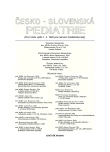-
Medical journals
- Career
Growth Charts for Breastfed Children and Growth Assessment of Infants and Young Children in the Czech Republic
Authors: J. Vignerová 1; L. Lhotská 2
Authors‘ workplace: Státní zdravotní ústav, Praha ředitel MUDr. J. Volf, PhD. 1; International Baby Food Action Network, Geneva, Switzerland Regional coordinator for Europe Lida Lhotska 2
Published in: Čes-slov Pediat 2005; 60 (11): 612-616.
Category: Current Information
Overview
Growth charts of basic body measurements are an important aid for daily routine practice of paediatricians. Charts for children from birth to 2 years of age are an integral component of the age spectrum to 18 years of age. The interpretation of the growth charts of breastfed children, commonly used for assessment of adequate nutrition by mother’s milk and for timing of introduction of complementary foods, is highly dependent on the adequacy of the reference data that is utilized. The decision about inadequacy of breastfeeding to support the infant’s nutritional needs may be inaccurate if charts that are being used represent incorrectly the physiological growth pattern of the breastfed child.
In the Czech Republic updates of growth references have been done since 1951 in 10-year intervals and have been based on results of nation-wide anthropological surveys of children and adolescents. In 1977, the World Health Organization (WHO) and the National Center for Health Statistics (NCHS), USA, recommended international reference growth charts for height for age, weight for age, and weight for height, which for children younger than 2 years were based on a longitudinal study of a North American infant population that was predominantly artificially fed.
Analysis of data regarding the growth of children exclusively and predominantly breastfed up to 4 months who continued to be breastfed for at least 12 months confirmed that such children deviate negatively when assessed against the current international reference. However, their growth pattern most likely better reflects “physiological growth” than the currently recommended NCHS/WHO international growth reference. Scientifically based knowledge of the broad impact of benefits inherent in breastfeeding supports the notion that the growth of a breastfed child should become the standard for physiological growth. In 1994 the World Health Organisation began planning the development of new international standards which would be based on a sample of healthy breastfed children from several countries.
While up to now all growth references are based on describing the current status of a given population, the new standards should better depict the actual physiological growth, i.e. how children should grow in all places. The project, the WHO Multicentre Growth Reference Study (MGRS), was carried out from 1997–2003. It focused on collection of growth and development data of 8440 children from different ethnic and cultural groups. The underlying assumption of the project was that in favourable socio-economic conditions and with a recommended level of nutrition and lack of smoking, children’s growth is very similar, regardless of their ethnic origin.
The objective of this article is to draw attention to a possibly incorrect model of growth charts for 0 - to 2-year-old Czech children. Although the new WHO standards are not yet available, we can hypothesize that percentile growth reference charts for Czech children might have a rather different trajectory than is foreseen to be the one in the forthcoming WHO Child Growth Standards.Key words:
growth references, growth standards, breastfeeding, child nutrition, anthropometry, child health
Labels
Neonatology Paediatrics General practitioner for children and adolescents
Article was published inCzech-Slovak Pediatrics

2005 Issue 11
Most read in this issue- Immunological Examinations in Pediatrics
- Growth Pain and Articular Hypermobility in Children
- Growth Charts for Breastfed Children and Growth Assessment of Infants and Young Children in the Czech Republic
- Reliability of Noninvasive Measurement of Bilirubin Concentration in Healthy Newborns
Login#ADS_BOTTOM_SCRIPTS#Forgotten passwordEnter the email address that you registered with. We will send you instructions on how to set a new password.
- Career

